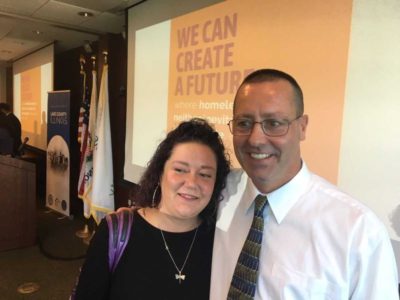They left “turfdom” and egos at the door.
About 30 social service agencies agreed to work in concert to end homelessness in Clay, Duval and Nassau counties by sharing data and resources, meeting monthly and involving local governments and community volunteers. They developed a centralized, one-stop system to prioritize people who need housing and other services.
Since 2009 the collaboration and intermittent financial support from government homelessness programs has reduced the number of homeless veterans in the three counties by 81 percent, chronic homelessness by 57 percent and overall homelessness by 27 percent.
But to achieve the ultimate goal — identifying and assisting a homeless person in 30 days or less, compared to the current rate of about 100 days — will require more money, resources and affordable housing. It will require governments and the community to make that goal a priority, said Dawn Gilman, CEO of Changing Homelessness, the lead homelessness-prevention agency for three counties.
“We know how to change homelessness in our community. It is not a manned mission to the moon,” she said. “It takes all of us.”
Meanwhile, the coalition will “keep moving the needle,” Gilman said.
Changing Homelessness has begun a monthly count in downtown Jacksonville, with staff and volunteers talking with homeless people and helping them begin or continue a housing plan. The goal is to better determine who is actually homeless downtown and what they need.
Also, the coalition will continue to whittle down veteran and chronic homelessness, in part by identifying the 20 people who have been homeless the longest, addressing their needs and moving on through the priority list.
Coalition members also increasingly promote the issue.
“Progress is going to be hindered by a lack of resources,” said Shannon Nazworth, executive director of Ability Housing, which creates affordable rental housing in Northeast and Central Florida. “We need to do a better job of engaging a broader community — businesses, elected officials, the faith community.”
They will also better explain the “return on investment” of ending homelessness, said Cindy Funkhauser, CEO and president of Sulzbacher, a Jacksonville center for the homeless. Placing homeless people in affordable housing, helping them get jobs and providing them with services to keep them stable costs 50 percent less than repeatedly housing them in shelters, she said.
“It makes a lot of sense,” she said.
In January for the annual Point-in-Time Count, nonprofit staff and volunteers fanned out to areas where homeless people congregate and identified them and their needs. This year 1,794 people were counted, compared to 1,869 last year and 2,442 in 2009. The reductions stemmed in part from the area collaboration and support since 2009 from an ongoing national initiative now called Built for Zero.


